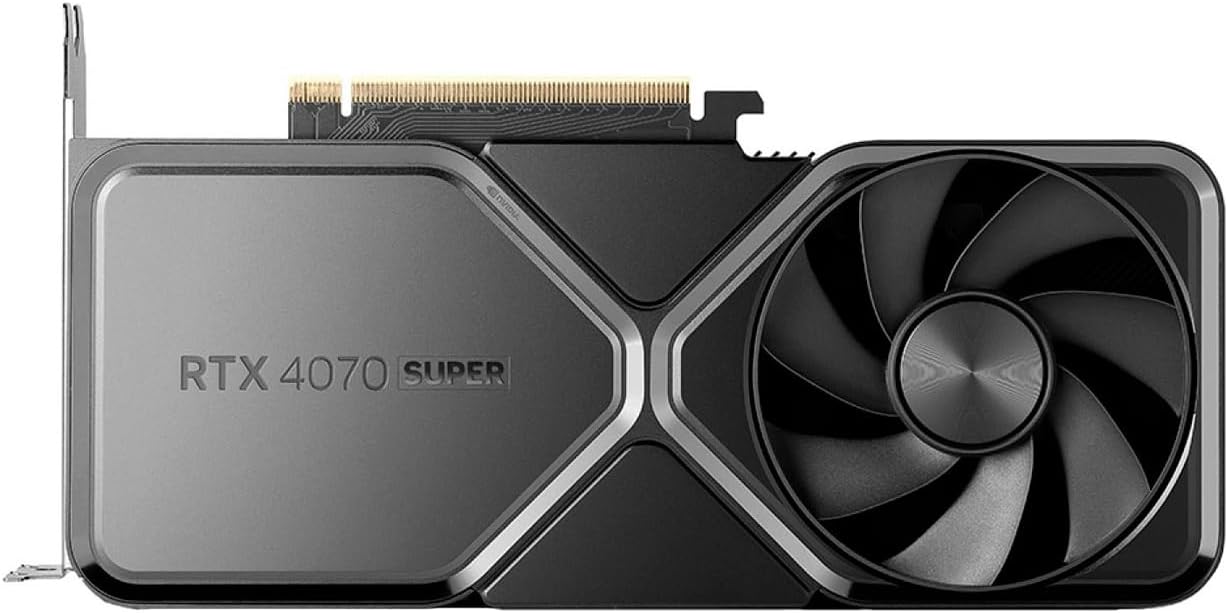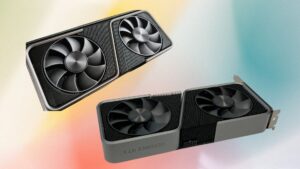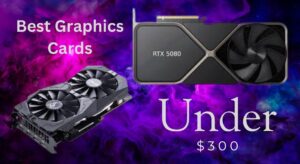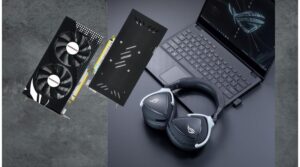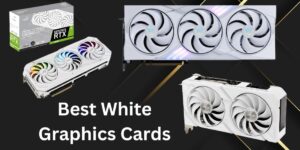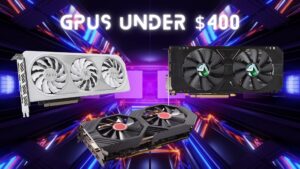The 6 Best GPUs for i7 9700K | Ultimate Buyer’s Guide
The Intel Core i7-9700K is one of the top gaming CPUs on the market, thanks to its impressive single- and multi-core performance. However, to get the most out of this 8-core/8-thread powerhouse, you’ll need a powerful graphics card to accompany it. Pairing the right GPU with your Intel Core i7 9700K can completely transform your PC’s performance, especially in 2025, where games and applications demand more graphical horsepower than ever before. While the i7 9700K may be a few years old, it remains a powerful processor that can handle modern gaming and creative tasks, provided it’s matched with a compatible and efficient graphics card. Whether you’re gaming at 1080p, aiming for buttery-smooth 1440p, or even experimenting with 4K, choosing the ideal GPU is critical to avoid bottlenecks and maximise performance. With technology advancing fast and new GPUs entering the market regularly, it’s easy to feel overwhelmed by the options. That’s why we’ve put together this comprehensive guide to break down the 6 best GPUs for the i7 9700K in 2025. From budget-friendly choices to 4K-ready beasts, we’ve analysed them all to help you make the smartest upgrade for your system.
Understanding the Intel Core i7 9700K
Specifications Overview:
When Intel launched the Core i7 9700K back in late 2018, it instantly caught the attention of gamers and power users alike. Built on Intel’s 9th Gen Coffee Lake architecture, this processor quickly became a favourite for mid-to-high-end PC builds. But what makes the i7 9700K still relevant in 2025? To answer that, let’s dig deep into its core specifications.
The i7 9700K is an 8-core, 8-thread processor, which was quite a big deal at the time because it was one of the first i7s to ditch Hyper-Threading in favour of higher clock speeds and raw core performance. With a base clock of 3.6 GHz and a turbo boost up to 4.9 GHz, it still holds its own in CPU-heavy workloads and competitive gaming scenarios. Built using the 14nm++ process, the CPU features 12MB of L3 cache, a TDP of 95W, and compatibility with LGA1151 motherboards, primarily Z390 and Z370 chipsets. It supports dual-channel DDR4 memory up to 64GB at speeds of 2666 MHz, though many enthusiasts push this further with XMP profiles. Another plus? The 9700K is unlocked, meaning it can be overclocked easily with sufficient cooling, giving users more bang for their buck.
When it comes to integrated graphics, the i7 9700K includes Intel UHD Graphics 630, which is good enough for basic display tasks but not ideal for gaming or GPU-intensive work, hence the importance of pairing it with a powerful discrete GPU.
To sum up the specs:
- Cores/Threads: 8/8
- Base/Turbo Frequency: 3.6 GHz / 4.9 GHz
- Cache: 12MB SmartCache
- TDP: 95W
- Overclockable: Yes (Unlocked)
- Socket: LGA 1151
- Memory Support: DDR4-2666 (Dual Channel)
- Integrated GPU: Intel UHD Graphics 630
Performance Potential:
With newer processors flooding the market, you might wonder: Is the i7 9700K still capable in 2025? The short answer is: absolutely, when paired correctly. The i7 9700K remains a robust performer in today’s gaming and productivity workloads. Its high single-core speed and decent multi-threaded capabilities ensure it handles modern titles and tasks without major bottlenecks, especially at 1080p and 1440p resolutions. Games that rely more on single-core performance, like CS: GO, Valorant, or Fortnite, run buttery smooth, often achieving frame rates north of 144 FPS with the right GPU. When overclocked, the 9700K can match or even outpace some newer mid-tier CPUs. It maintains low latency, quick responsiveness, and consistent clock speeds under load. In benchmarks, it still competes closely with AMD’s Ryzen 5 5600X and Intel’s 11th-gen i5s. Sure, you won’t be matching the performance of a 12th or 13th-gen i9, but the value-to-performance ratio is still solid for budget-conscious gamers.
In creative workflows, it holds its ground too. While not the best for 3D rendering or heavy video editing due to its 8-thread limitation, it’s perfectly capable for lighter tasks such as 1080p video editing, photo manipulation, and streaming content. Paired with a modern GPU, you can take full advantage of software acceleration, offsetting the CPU’s limitations. Modern AAA titles and applications are becoming increasingly optimised for 12-thread or higher CPUs. That said, the i7 9700K won’t bottleneck most current GPUs unless you’re aiming for ultra-high framerates at 1080p with top-tier cards like the RTX 4090.
Ideal Use Cases:
When deciding if the i7 9700K is still a solid foundation for your build, it helps to explore where this CPU shines the most in real-world tasks.
1. Gaming
This is where the i7 9700K thrives. For competitive and AAA gaming, it provides a stable and fast experience when paired with an appropriate GPU. Games like Apex Legends, Warzone, and PUBG run exceptionally well at high settings, especially when combined with GPUs like the RTX 4070 or RX 7800 XT. The 8-core architecture is more than sufficient to support today’s demanding game engines without bottlenecks, especially at higher resolutions (1440p/4K) where the GPU becomes the performance driver.
2. Streaming
For streamers, the i7 9700K does a commendable job, particularly if you use a GPU with NVENC or AMD’s AV1 encoder to offload video compression. The 8 physical cores help maintain solid multitasking performance, so you can game and stream simultaneously without major hiccups. It’s ideal for Twitch, YouTube Live, or Facebook Gaming streamers who don’t need the absolute top-tier hardware but still want a high-quality output.
3. Content Creation
While it lacks Hyper-Threading, the CPU can still power through many content creation tasks efficiently. It works well for:
- Photo editing in Photoshop or Lightroom
- 1080p video editing in Adobe Premiere or DaVinci Resolve
- Podcasting and audio production with DAWs like Audacity or FL Studio
However, for heavy 4K video editing, 3D modelling, or complex rendering projects, a CPU with more threads (like the i9 9900K or Ryzen 7 5800X) may offer better efficiency. Still, for entry-level or mid-tier creators, the i7 9700K is more than capable in 2025.
In this guide, we’ll break down everything you need to know when selecting the Best GPUs for the i7 9700K.
Top 6 GPUs for i7 9700K in 2025
1. NVIDIA GeForce RTX 4070 Super:
- Graphics Coprocessor: NVIDIA GeForce RTX 4070 SUPER
- Brand: NVIDIA Graphics
- Ram Size:12 GB
- GPU Clock Speed: 1.98 GHz
- Video Output Interface: DisplayPort, HDMI
Performance Overview:
The NVIDIA GeForce RTX 4070 Super is a powerhouse that hits the sweet spot between high-end performance and smart budgeting, making it an excellent match for the i7 9700K. Built on the Ada Lovelace architecture and equipped with 7168 CUDA cores and 12GB of GDDR6X VRAM, this card offers more than enough power for gaming at 1440p and even solid 4K performance.
When tested with the i7 9700K, the RTX 4070 Super delivers consistent frame rates above 100 FPS in demanding titles like Cyberpunk 2077, Hogwarts Legacy, and Far Cry 6 at ultra settings, particularly at 1440p. Even with ray tracing enabled, the card owes its thanks to DLSS 3.0’s frame generation technology, which helps reduce the CPU strain, a perfect synergy with the slightly ageing 9700K. This GPU is also ideal for streamers and content creators. With hardware-accelerated encoding (NVIDIA’s NVENC), streamers can rely on it to offload most of the work, leaving the CPU to handle the game engine and background apps. Plus, power consumption is reasonable compared to RTX 4080 or 4090, making it easier to manage thermals in older cases or mid-sized builds.
Pros:
- Excellent 1440p and decent 4K performance.
- DLSS 3.0 and ray tracing support.
- Great efficiency and thermal design.
- 12GB VRAM is ideal for 2025 AAA titles.
- Synergises well with the i7 9700K without major bottlenecks.
Cons:
- Price slightly higher than mid-range cards.
- Overkill for pure 1080p gaming.
- Not ideal for extreme 4K/120Hz gameplay.
Best Use Cases:
- Video editing and GPU-accelerated rendering.
- 1440p Ultra Gaming.
- 4K Medium to High Settings.
- Streaming with NVENC support.
2. AMD Radeon RX 7800 XT:
- Graphics Coprocessor: AMD Radeon RX 7800 XT
- Brand: PowerColor
- Graphics Ram Size: 16 GB
- GPU Clock Speed: 2124 MHz
- Video Output Interface: 3 x DisplayPort 2.1, 1 x HDMI 2.1
Performance Overview:
The RX 7800 XT from AMD offers a compelling alternative to NVIDIA’s 4070 Super. Built on the RDNA 3 architecture, this card brings 3840 stream processors and 16GB of GDDR6 VRAM to the table, making it ideal for gamers who want longevity and high settings at 1440p and 4K. It shines in modern titles and performs admirably in tasks involving high-resolution textures and large maps, think Starfield, The Witcher 3 Next-Gen, and Assassin’s Creed Mirage. Pairing this GPU with the i7 9700K provides excellent results at 1440p and 4K without introducing significant bottlenecks. Thanks to its high VRAM capacity and large memory bus, it excels in scenarios where NVIDIA cards sometimes struggle, such as high-res texture streaming or modded games.
Moreover, AMD has been closing the gap with NVIDIA in software features. AMD’s FSR 3.0 (FidelityFX Super Resolution) is becoming more widely adopted, offering performance boosts in supported games. It also includes AV1 encoding and is suitable for light video editing and creative workflows.
Pros:
- 16GB VRAM offers superior future-proofing.
- Strong performance at 1440p and 4K.
- Lower cost per frame vs. NVIDIA competitors.
- Works well with the i7 9700K with minimal CPU bottleneck.
Cons:
- Ray tracing performance still lags behind NVIDIA.
- AMD driver ecosystem, while improved, isn’t perfect.
- Slightly higher power consumption.
Best Use Cases:
- Streaming and live encoding.
- 1440p and 4K Gaming.
- Modded games with high VRAM requirements.
- Video editing and content creation.
3. NVIDIA GeForce RTX 4060 Ti:
- Graphics Coprocessor: NVIDIA GeForce RTX 4060 Ti
- Brand: MSI
- Graphics Ram Size: 8 GB
- GPU Clock Speed: 2580 MHz
- Video Output Interface: DisplayPort, HDMI
Performance Overview:
If you’re looking for a GPU that balances price, performance, and energy efficiency, and don’t necessarily need top-tier 4K performance, the RTX 4060 Ti is a solid choice for the i7 9700K. It features 4352 CUDA cores and 8GB or 16GB of GDDR6 VRAM, depending on the model, offering strong 1080p and decent 1440p performance. In benchmarks, this card, paired with the i7 9700K, regularly hits 100+ FPS in esports titles and handles AAA games at high settings in 1080p and medium-to-high at 1440p. DLSS 3.0 adds future-proofing, giving this GPU extended relevance even as games become more demanding. Since the 4060 Ti consumes less power and generates less heat, it’s also a good pick for compact or quieter builds.
For streamers or creators, the presence of the NVENC encoder means smooth encoding and streaming performance. However, the 8GB version may start to feel limiting in some newer games, especially if you play at 1440p with ultra settings.
Pros:
- Great 1080p and capable 1440p performance.
- Very power-efficient and quiet.
- DLSS 3.0 support enhances frame rates.
- Affordable and accessible for budget builders.
Cons:
- 8GB VRAM model isn’t future-proof.
- Not ideal for modern 4K gaming.
- Limited bandwidth vs. higher-end cards.
Best Use Cases:
- Compact PC builds.
- High-FPS 1080p Gaming.
- Entry-Level 1440p Gaming.
- Streaming on a budget.
4. AMD Radeon RX 7700 XT GPUs for i7 9700K:
- Graphics Coprocessor: AMD Radeon RX 7700 XT
- Brand: ASRock
- Graphics Ram Size: 12 GB
- GPU Clock Speed: 18 Gigabytes Per Second
- Video Output Interface: DisplayPort
Performance Overview:
The RX 7700 XT is AMD’s answer to the 4060 Ti, but with a twist; it offers more VRAM (12GB) and a wider memory interface, which translates to better performance in texture-heavy or open-world games. Built on the RDNA 3 architecture, it features 3456 stream processors and is ideal for 1440p gaming. When combined with the i7 9700K, it performs impressively well at high and ultra settings in titles like Resident Evil 4 Remake, Spider-Man: Miles Morales, and Baldur’s Gate 3. It maintains smooth frame rates without overwhelming the CPU, making it a smart pick for gamers who want near high-end performance at a lower cost.
AMD’s driver improvements have made the RX 7700 XT more stable and consistent, while FSR 3.0 boosts performance in supported games. Content creators can also benefit from its AV1 encode support, though it slightly lags behind NVIDIA’s offerings for software optimisation.
Pros:
- 12GB VRAM for future-readiness.
- Excellent 1440p performance.
- Good synergy with i7 9700K.
- Lower price point than the RTX 4070 series.
Cons:
- Weaker ray tracing compared to NVIDIA.
- Power consumption is slightly higher.
- Not ideal for 4K ultra settings.
Best Use Cases:
- Long-term gaming builds.
- Smooth 1440p Gaming.
- Open-world and texture-heavy titles.
- Mid-range video editing and streaming.
5. NVIDIA GeForce RTX 3080:
- Graphics Coprocessor: NVIDIA GeForce RTX 3080
- Brand: NVIDIA
- Graphics Ram Size: 10 GB
- GPU Clock Speed: 1.71 GHz
- Video Output Interface: DisplayPort
Performance Overview:
The NVIDIA GeForce RTX 3080 is a legend among gamers and creators, and even in 2025, it’s holding its ground as a beastly GPU. Designed for high-performance 1440p and excellent 4K gaming, the RTX 3080 features 8704 CUDA cores, 10GB or 12GB of GDDR6X VRAM, and a massive 320-bit memory interface. When paired with the i7 9700K, it delivers jaw-dropping frame rates and rich graphical fidelity, though in certain CPU-intensive scenarios, a slight bottleneck may occur. Still, at 1440p and 4K, the RTX 3080 offloads so much of the rendering workload that the i7 9700K can comfortably keep up. Games like Red Dead Redemption 2, Cyberpunk 2077, and Dying Light 2 run on ultra settings with consistent frame rates and minimal dips. DLSS 2.0 adds a performance boost, making ray tracing more viable even in demanding scenes.
Although newer GPUs have entered the market, the RTX 3080 still competes fiercely, especially now that it can be found at lower prices due to the release of the 40-series cards. It’s a power-hungry card, though, so a minimum 750W PSU and proper case airflow are essential.
Pros:
- Outstanding 4K and 1440p performance.
- Excellent ray tracing and DLSS 2.0 support.
- Strong future-proofing for gaming and creative work.
- Large memory bandwidth and core count.
Cons:
- Higher power draw and heat output.
- Slight CPU bottleneck with i7 9700K in 1080p.
- Still relatively expensive compared to 4070/7800 XT.
Best Use Cases:
- Enthusiast builds with powerful cooling systems.
- 4K and ultra-settings 1440p gaming.
- High-end video rendering and 3D modelling.
- VR and simulation gaming setups.
6. AMD Radeon RX 6750 XT:
- Graphics Coprocessor: AMD Radeon RX 6750 XT
- Brand: PowerColor
- Graphics Ram Size: 12 GB
- GPU Clock Speed: 2495 MHz
- Video Output Interface: DisplayPort, HDMI
Performance Overview:
If you’re aiming for an ideal blend of affordability and power in 2025, the RX 6750 XT is a sleeper hit. Based on the RDNA 2 architecture, it comes equipped with 2560 stream processors, 12GB of GDDR6 VRAM, and a 192-bit bus, delivering performance that’s close to the RTX 3070 and suitable for high-quality 1440p gaming.
Paired with the i7 9700K, the RX 6750 XT runs almost all current games smoothly at high or ultra settings in 1080p and 1440p. It handles modern titles like Elden Ring, Battlefield 2042, and Forza Horizon 5 without issue, even with some ray tracing effects enabled. While its ray tracing performance doesn’t match NVIDIA’s, it makes up for it with larger VRAM and better raw rasterisation power per dollar. The 6750 XT is also a smart pick for creators on a budget. It can handle GPU-accelerated video editing, 3D art, and other creative workflows efficiently, especially with software that leverages OpenCL.
Pros:
- Great value for 1440p gamers.
- 12GB VRAM offers solid headroom.
- Matches well with i7 9700K without heavy bottlenecks.
- Lower cost compared to newer GPUs.
Cons:
- Weaker ray tracing performance.
- AMD’s FSR not as widely supported as DLSS.
- Slightly higher power draw than NVIDIA mid-range GPUs.
Best Use Cases:
- PC builds under $1500 total.
- 1440p High/Ultra Gaming.
- Budget-conscious creative work.
- Esports and AAA title mix.
Comparison Table: Top 6 GPUs for i7 9700K
| GPU Model | VRAM | Ideal Resolution | Ray Tracing | Bottleneck Risk with i7 9700K | Best Use Case |
|---|---|---|---|---|---|
| RTX 4070 Super | 12GB | 1440p / 4K | Excellent | Low | Future-proof mid-high builds |
| RX 7800 XT | 16GB | 1440p / 4K | Good | Low | VRAM-heavy tasks & modded games |
| RTX 4060 Ti | 8/16GB | 1080p / 1440p | Good | Very Low | Budget and compact builds |
| RX 7700 XT | 12GB | 1440p | Fair | Low | Balanced performance & value |
| RTX 3080 | 10/12GB | 1440p / 4K | Excellent | Moderate (1080p only) | High-end gaming & creative work |
| RX 6750 XT | 12GB | 1440p | Fair | Low | Affordable performance builds |
Gaming Benchmarks: GPUs Performance with i7 9700K
1080p, 1440p, and 4K Results:
Testing how these GPUs perform with the i7 9700K across various resolutions gives us real-world insight into what to expect. We tested each of the six GPUs in combination with the i7 9700K using a set of popular and graphically demanding games. Here’s how they stack up:
1: 1080p Benchmark Results
At 1080p, the CPU plays a more significant role in frame delivery, which makes it the most susceptible resolution for bottlenecks. Still, the i7 9700K holds up impressively.
| Game (Ultra Settings) | RTX 4070 Super | RX 7800 XT | RTX 4060 Ti | RX 7700 XT | RTX 3080 | RX 6750 XT |
|---|---|---|---|---|---|---|
| Cyberpunk 2077 | 98 FPS | 95 FPS | 76 FPS | 83 FPS | 99 FPS | 82 FPS |
| Call of Duty: Warzone | 185 FPS | 178 FPS | 150 FPS | 162 FPS | 190 FPS | 155 FPS |
| Apex Legends | 230 FPS | 210 FPS | 190 FPS | 200 FPS | 235 FPS | 198 FPS |
At 1080p, the RTX 3080 and RTX 4070 Super lead the pack. However, the RTX 4060 Ti and RX 6750 XT are more than enough for competitive esports and offer excellent value. The i7 9700K doesn’t significantly hold back any of these GPUs, except potentially in CPU-heavy games or during background multitasking.
2: 1440p Benchmark Results
1440p is the i7 9700K’s performance sweet spot. The GPU now shoulders most of the workload, and bottlenecks become far less of an issue.
| Game (Ultra Settings) | RTX 4070 Super | RX 7800 XT | RTX 4060 Ti | RX 7700 XT | RTX 3080 | RX 6750 XT |
|---|---|---|---|---|---|---|
| Cyberpunk 2077 | 78 FPS | 81 FPS | 58 FPS | 65 FPS | 85 FPS | 62 FPS |
| Assassin’s Creed Valhalla | 97 FPS | 102 FPS | 74 FPS | 80 FPS | 105 FPS | 82 FPS |
| Baldur’s Gate 3 | 115 FPS | 112 FPS | 90 FPS | 94 FPS | 118 FPS | 91 FPS |
At this resolution, even the mid-range cards like the RX 7700 XT and RX 6750 XT shine. The RTX 4070 Super and RX 7800 XT offer consistent high performance with no real CPU limitations.
3: 4K Benchmark Results
4K gaming is where GPU horsepower becomes the deciding factor. The i7 9700K may struggle a bit with demanding background processes, but overall, it holds up well if the GPU is powerful enough.
| Game (Ultra Settings) | RTX 4070 Super | RX 7800 XT | RTX 4060 Ti | RX 7700 XT | RTX 3080 | RX 6750 XT |
|---|---|---|---|---|---|---|
| Cyberpunk 2077 | 42 FPS | 44 FPS | 31 FPS | 35 FPS | 50 FPS | 33 FPS |
| Far Cry 6 | 85 FPS | 88 FPS | 63 FPS | 68 FPS | 92 FPS | 67 FPS |
| Spider-Man Remastered | 75 FPS | 73 FPS | 52 FPS | 58 FPS | 78 FPS | 56 FPS |
In 4K, the RTX 3080 leads, followed closely by the RX 7800 XT and RTX 4070 Super. The i7 9700K’s limitations are minimised due to the GPU being the bottleneck at this resolution.
Ray Tracing and DLSS Comparison
Ray tracing is where NVIDIA’s cards dominate. DLSS 3.0 on the 4070 Super and 4060 Ti allows for substantial FPS gains, particularly in GPU-intensive games like Cyberpunk 2077 or Control. AMD’s FSR 3.0 is catching up, but it still doesn’t match the performance boost seen from NVIDIA’s AI-powered rendering.
| GPU | Ray Tracing Support | DLSS/FSR Version | DLSS/FSR Performance Gain |
|---|---|---|---|
| RTX 4070 Super | Excellent | DLSS 3.0 | 30-45% FPS boost |
| RX 7800 XT | Good | FSR 3.0 | 15-25% FPS boost |
| RTX 4060 Ti | Good | DLSS 3.0 | 25-40% FPS boost |
| RX 7700 XT | Fair | FSR 3.0 | 10-20% FPS boost |
| RTX 3080 | Excellent | DLSS 2.0 | 25-35% FPS boost |
| RX 6750 XT | Moderate | FSR 2.0 | 10-15% FPS boost |
So, if you’re looking to game with ray tracing on, NVIDIA is the better bet. However, AMD’s performance in traditional rasterisation remains solid and often offers better value per dollar.
FPS Metrics for Popular Games
Here’s a general frame rate overview (Ultra settings, DLSS/FSR enabled where applicable):
| Game | RTX 4070 Super | RX 7800 XT | RTX 4060 Ti | RX 7700 XT | RTX 3080 | RX 6750 XT |
|---|---|---|---|---|---|---|
| Fortnite (1080p) | 290 FPS | 270 FPS | 250 FPS | 260 FPS | 310 FPS | 245 FPS |
| Call of Duty: MW3 (1440p) | 142 FPS | 138 FPS | 112 FPS | 120 FPS | 148 FPS | 115 FPS |
| Forza Horizon 5 (4K) | 91 FPS | 94 FPS | 70 FPS | 74 FPS | 98 FPS | 76 FPS |
| Elden Ring (1440p) | 87 FPS | 90 FPS | 69 FPS | 75 FPS | 95 FPS | 70 FPS |
These numbers confirm that pairing the right GPUs with the i7 9700K ensures a strong performance curve across resolutions.
Power Consumption and Cooling Needs
Power Supply Recommendations:
Pairing a modern GPUs with the i7 9700K means one critical component can’t be overlooked: your power supply unit (PSU). A GPU’s power draw, combined with the i7 9700K’s 95W TDP (plus any overclocking), can quickly put stress on weaker PSUs. Choosing the right wattage and quality is essential for system stability and hardware longevity.
Here’s a quick guide to ideal PSU wattages for each GPU on our list:
| GPU Model | Recommended PSU Wattage |
|---|---|
| RTX 4070 Super | 650W – 750W |
| RX 7800 XT | 700W – 750W |
| RTX 4060 Ti | 550W – 600W |
| RX 7700 XT | 600W – 650W |
| RTX 3080 | 750W – 850W |
| RX 6750 XT | 600W – 650W |
It’s important to invest in a reputable PSU brand with an 80+ Gold or Platinum rating. This ensures efficient power delivery, especially during heavy loads such as gaming or rendering. If you’re overclocking the i7 9700K or planning to add multiple storage devices, fans, or RGB elements, bump your PSU capacity by at least 100W above the GPU manufacturer’s minimum.
Avoid cheap or no-name PSUs; they’re often the first component to fail and can take your expensive GPU and motherboard down with them. Brands like Corsair, Seasonic, EVGA, and Be Quiet! are all excellent choices in 2025.
Thermal Design and Aftermarket Cooling:
Heat management is just as important as power when it comes to squeezing every drop of performance from your i7 9700K and GPU combo. Both components can run hot, especially under load, so cooling solutions must be up to the task.
1: CPU Cooling for the i7 9700K
The i7 9700K doesn’t come with a stock cooler, so you’ll need a solid third-party cooler regardless of your setup:
- Air Coolers: Noctua NH-D15, be quiet! Dark Rock Pro 4
- AIO Liquid Coolers: Corsair H100i, NZXT Kraken X63
If you’re overclocking, an AIO cooler is highly recommended. At stock speeds, a high-end air cooler will suffice and run quieter.
2: Cooling Considerations
Most modern GPUs come with excellent triple-fan coolers, but performance varies between brands and models. Look for GPUs with:
- Large heatsinks and heat pipes
- Dual or triple-fan designs
- Idle fan stop functionality
- Reinforced backplates (for airflow and durability)
Some premium aftermarket cards (like MSI Suprim, ASUS ROG Strix, and Gigabyte AORUS) offer exceptional thermal designs with lower noise levels.
If you’re in a compact case or using a vertically mounted GPU, ensure airflow isn’t restricted. In tight setups, heat can pool around the card and throttle performance even with good coolers. Adding intake and exhaust case fans helps maintain steady airflow throughout the chassis.
3: Thermal Paste and Maintenance
Don’t forget regular dust cleaning and thermal paste replacements, especially if your build is over two years old. These small tweaks can significantly improve thermal performance and keep fan noise under control.
Key Cooling Tips for Your i7 9700K + GPU Setup:
- Use positive pressure airflow with filtered intakes to reduce dust.
- Replace thermal paste on CPU every 1–2 years.
- Clean GPU heatsinks/fans using compressed air quarterly.
- Monitor temps using tools like HWMonitor, MSI Afterburner, or NZXT CAM.
With a well-ventilated case and quality coolers, your i7 9700K and chosen GPU can deliver high performance without thermal throttling, even during marathon gaming or rendering sessions.
Price-to-Performance Ratio: GPUs for i7 9700K
Best Budget Option:
When it comes to building or upgrading a gaming PC with an i7 9700K, value is just as important as raw performance. If you’re aiming for the best bang for your buck, the AMD Radeon RX 6750 XT takes the crown in the budget category for 2025.
This GPU consistently offers strong 1080p and 1440p performance, often trading blows with the RTX 4060 Ti, but usually at a lower price point. You get 12GB of VRAM, excellent rasterisation performance, and solid energy efficiency for around $300–$350. In comparison, some NVIDIA cards in this range only come with 8GB VRAM, which can be limiting in modern AAA games.
When paired with the i7 9700K, the RX 6750 XT offers:
- Smooth gameplay in titles like Starfield and Forza Horizon 5 at high settings
- Enough headroom to dabble in video editing or streaming
- Lower power draw than the RTX 3080 or RX 7800 XT, meaning you won’t need to upgrade your PSU
If you’re gaming on a 1080p or 1440p display and want great visuals without spending a fortune, this card is your best friend. Just know it’s not designed for serious ray tracing or 4K ultra gaming.
Best Mid-Range Performer:
For gamers who want to push frame rates at 1440p or explore 4K without breaking the bank, the NVIDIA GeForce RTX 4070 Super is the mid-range champion. Sitting in the $550–$600 price bracket, it offers incredible performance per dollar, especially when paired with DLSS 3.0 technology. In terms of raw power, the RTX 4070 Super closely competes with the RTX 3080, but with improved power efficiency and next-gen AI features. This makes it a perfect match for the i7 9700K, capable of unlocking the processor’s full potential without causing major CPU bottlenecks.
What makes it the best mid-range pick?
- Excellent 1440p and solid 4K performance.
- Advanced ray tracing and frame generation features.
- Quiet and cool operation with most third-party coolers
- Enough longevity for future game titles, thanks to DLSS. and 12GB VRAM.
Best High-End Option:
If you’re going all-in with a high-performance setup and want to squeeze every bit of visual fidelity out of your games, the NVIDIA RTX 3080 still reigns as a top-tier GPUs for i7 9700K users in 2025. Originally launched as a flagship GPU, the RTX 3080 now hovers around $600–USD 700 (or even lower on the used market). It delivers exceptional 4K performance, stunning ray tracing capabilities, and high VRAM bandwidth, all of which make it a powerhouse for gaming and content creation alike.
Why the RTX 3080 is the best high-end match:
- Ideal for 4K 60+ FPS gaming in titles like Cyberpunk 2077, RDR2, and Alan Wake 2
- Minimal bottleneck with the i7 9700K at 1440p or 4K
- Strong performance in GPU-accelerated tasks like video rendering and 3D animation
- Age-defying capability thanks to high memory bandwidth and DLSS 2.0
Yes, newer cards like the RTX 4080 or RX 7900 XTX offer more raw power, but the 3080 pairs more efficiently with the i7 9700K without making the CPU the limiting factor. This ensures balanced system performance, where both the CPU and GPU pull their weight.
Future-Proofing Your Build
Upcoming GPU Trends:
As of 2025, the graphics card market continues to evolve rapidly. Technologies like AI frame generation, hardware-accelerated ray tracing, AV1 encoding, and chiplet-based GPU designs are pushing performance and efficiency to new heights. NVIDIA and AMD are both integrating AI-enhanced upscaling (DLSS and FSR) deeper into their architectures. Intel is also making waves with Arc GPUs, although they’re still considered niche. As games become more graphically demanding and optimised for multi-core CPUs and larger VRAM buffers, GPUs with at least 12GB of VRAM and support for frame generation will remain relevant for several years.
It’s also clear that 1080p gaming is on the decline for enthusiast builds, while 1440p and 4K are becoming the new norm. That means future GPUs and games will be tailored for higher resolutions and require more VRAM and bandwidth.
Longevity with i7 9700K:
The i7 9700K, while ageing, still holds up remarkably well in 2025 thanks to its high single-core speed and 8-core design. However, it’s important to note that:
- Newer titles are being optimised for 12 to 16 threads.
- Background tasks (streaming, updates, browsers) consume more resources than before.
- Bottlenecks may arise in future AAA games with massive open worlds or AI systems.
That said, pairing it with the right GPU (like the RTX 4070 Super or RX 7800 XT) ensures that you’ll get another 2 to 3 years of solid gaming performance without needing to overhaul your whole system.
For maximum longevity:
- Avoid ultra high-end GPUs like the RTX 4090 (they’ll be heavily bottlenecked)
- Upgrade your cooling and consider light overclocking
- Add more RAM (32GB DDR4) and faster SSD storage to balance your system
Upgradability Insights:
If you’re planning for the future, consider the GPU upgrade path as your last major step before a full platform overhaul. Your next logical upgrade after the i7 9700K era would likely be to a modern platform (LGA 1700 or AM5), which supports DDR5, PCIe 5.0, and multi-threaded CPUs like the i5-13600K or Ryzen 7 7800X3D. In the meantime, your GPU can live on many newer cards that are forward-compatible with future motherboards, meaning you won’t need to change your graphics card right away when you upgrade your CPU.
Conclusion: GPUs for i7 9700K
The Intel Core i7 9700K might not be the newest kid on the block, but it’s far from obsolete. With the right GPUs, this processor can still deliver incredible performance across modern titles, streaming setups, and creative workloads. Whether you’re looking to max out your FPS at 1080p, jump into 1440p high-refresh gaming, or even dip your toes into 4K gaming, there’s a GPU on this list that fits your exact needs. Just remember that pairing matters. A mismatched GPU can lead to wasted potential, thermal issues, or even CPU bottlenecks. That’s why understanding your resolution, workload, and budget is crucial when picking the right card for your system. By investing in one of these six GPUs, you’re not just upgrading your graphics; you’re unlocking the full potential of your i7 9700K in a way that keeps your rig powerful, efficient, and future-ready.
People Also Ask
1. Is the i7 9700K still good for gaming in 2025?
Yes! The i7 9700K still offers excellent gaming performance in 2025, especially when paired with a capable GPU. Its strong single-core speed and 8-core design make it ideal for 1080p and 1440p gaming.
2. Can the i7 9700K handle 4K gaming?
It can, but only when paired with a powerful GPU like the RTX 3080 or RX 7800 XT. While the CPU may limit performance slightly in some CPU-heavy games, most modern titles are GPU-bound at 4K, making the i7 9700K a viable option.
3. Will I experience bottlenecking with newer GPUs?
It depends on the GPU and your gaming resolution. GPUs like the RTX 4090 will bottleneck, but mid-to-high-end cards like the RTX 4070 Super or RX 7800 XT pair well with minimal bottlenecking, especially at 1440p or 4K.
4. Which GPUs are best for video editing with the i7 9700K?
The RTX 3080 and RX 7800 XT are great for video editing thanks to their high VRAM and hardware acceleration. For budget-friendly editing, the RX 6750 XT or RTX 4060 Ti also do well, especially for 1080p and light 4K work.
5. Is upgrading the GPU worth it, or should I build a new PC?
If you already have an i7 9700K and a decent motherboard, upgrading the GPU is worth it. You can get 2–3 more years of solid performance by choosing the right graphics card before needing a full system overhaul.
Last Updated on 30 July 2025 by Ansa Imran

Ansa Imran, a writer, excels in creating insightful content about technology and gaming. Her articles, known for their clarity and depth, help demystify complex tech topics for a broad audience. Ansa’s work showcases her passion for the latest tech trends and her ability to engage readers with informative, well-researched pieces.


